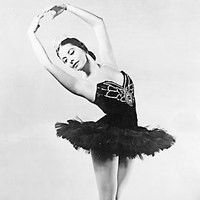La Habana (Cuba), 1921
Por Valerio Cesio
Born in Havana, Alicia Ernestina Martinez Hoyo was the first Caribbean ballerina to gain international recognition in classical ballet. She took the surname Alonso from Fernando Alonso, her husband, and mentor, who accompanied and guided her throughout most of her career.
Alicia trained in Cuba and later in New York with Vilzak and at the School of American Ballet (SAB). She began her professional career in 1938 in Broadway musicals. In 1939, she joined Ballet Caravan, and in 1940, she joined Ballet Theatre, where she performed, with some interruptions, until 1960.
Between 1941 and 1943, she performed with the Pro-Arte group in Havana, and in 1948, she founded the Ballet Alicia Alonso in her hometown (along with its associated school in 1950). Starting in 1955, the company was renamed Ballet de Cuba. During this period, Alonso participated in important world premieres such as Undertow by A. Tudor (1945), Theme and Variations by G. Balanchine (1947), and Fall River Legend by A. de Mille, among others.
Between 1955 and 1960, she also performed as a guest dancer with various companies, including the Ballet Russe de Monte Carlo.
After Fidel Castro’s rise to power in 1959, she was appointed director of the National Ballet of Cuba. While her work as a choreographer and director was often controversial, as a ballerina she is universally regarded as a landmark figure in Latin American ballet.
Some of her most iconic roles included Giselle (which she first performed in 1945), Swan Lake (since 1954), Carmen (since 1967), and The Sleeping Beauty (since 1974). Her most notable characteristic was her exceptional technical skill, almost unprecedented for the time, combined with a powerful stage presence, which led to widespread public acclaim.
She was awarded the Médaille de la Ville de Paris and the Prix Pavlova in 1966.




